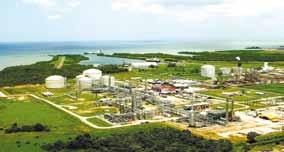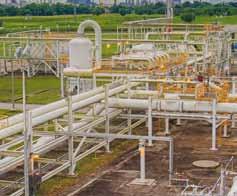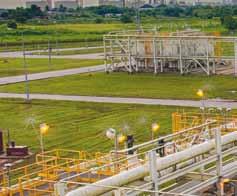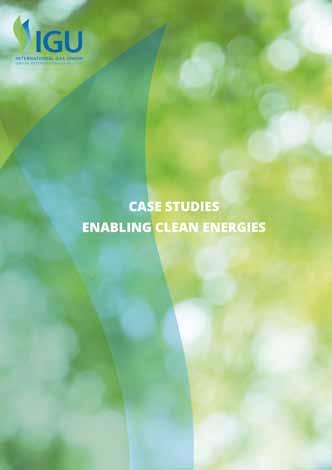
11 minute read
Reports from the Regional Coordinators
from IGU Magazine October 2016
by IGU
Khaled Abubakr.
v The FSRU Höegh Gallant,
seen here on station at Ain Sokhna, was the first of Egypt’s floating storage and regasification vessels.
In this issue we bring you updates from IGU’s Regional Coordinators for Africa and the Middle East; Latin America and the Caribbean; and from Russia, the Black Sea and Caspian Area.
Update on developments in Africa and the Middle East
By Khaled Abubakr
Sub-Saharan Africa
Last April, South Africa hosted the Executive Committee meetings in Durban (for a full report see pages 40-42). This was a major milestone to bring the gas world to Africa and Africa to the gas world.
The meetings, and the workshop that followed, were very interesting and confirmed a different dimension and role for gas to enhance quality of life and fuel ambitious economic growth. The level of participation and speakers from governments and different International and financial organisations confirmed two major conclusions:
◆ For Africa, gas is the future. ◆ IGU has a major role to play in this part of the world.
In IGU we are very excited about these two conclusions. It puts more responsibility on the shoulders of the USA triennium.
East and West Africa
Many investment decisions are pending in East Africa, mainly due to the impact of low gas prices and the high cost of E&P and LNG projects, slowing down most development processes. However, West Africa has witnessed more progress in development, floating storage and regasification and utilisation of Gas.
North Africa and East Mediterranean
Both Algeria and Egypt’s markets are getting more dependent on gas as a prime source of energy to spur on their economic growth.
In Egypt, huge progress has been made in developing ENI’s newly discovered Zohr gas dep
osit, estimated to contain 849.5 bcm of gas, with production scheduled to start in 2017-2018.
In the East Mediterranean, the concept of developing a regional hub is becoming more solid thanks to the progress and cooperation of the different governments involved. Israel’s Delek and the USA’s Noble are on the verge of exporting gas from the Levant Basin to Egypt and Jordan, with a licence already issued for Egypt.
Middle East
Gulf countries are becoming more wise consumers of gas, focusing on efficiency and optimising gas utilisation.
Iraq and Syria are on hold until the region embraces more peace and stability.
Jordan is using its new Floating Storage and Regasification Unit (FSRU) almost to its full capacity, while Egypt has commissioned its second FSRU and launched a bid for a third.
Finally, with all these excitements and the dynamism in the region, we in the IGU have worked to carefully shaped our message to world leaders for delivery at China’s G20 Natural Gas Day.
Khaled Abubakr is Chairman of TAQA Arabia and the IGU Regional Coordinator for Africa and the Middle East.

Developments in Latin America and the Caribbean
By Javier Gremes Cordero
Regional overview
Natural gas accounts for 26% of the Latin American and Caribbean energy matrix. The environmental advantages presented by natural gas for industrial, electricity or transportation purposes as a substitute for coal and liquid fuels lead to the assumption that in the approaching decades gas will considerably increase its share in the worldwide and regional energy matrix. There is a solid international consensus that supports this expected trend.
The need to decarbonise the economy, the growing share of non-conventional renewable energies in the electricity generation matrix, greater NGL market fluidity given the expected increase of supply, global availability and fast-evolving technological advances will increase the flexibility and competitiveness of liquefaction and regasification investments.
The Latin American and Caribbean region produces approximately 7% of the world’s natural gas and its deficit is covered by means of imports. The demand for natural gas presents a growing trend derived from natural
Javier Gremes Cordero.
c Argentina’s huge
unconventional gas reserves, while currently supplying the country, show great potential for future production.
x The Guanabara Bay
LNG Regasification Terminal in Rio de Janeiro. There are currently nine terminals in the region and regas capacity continues to grow to meet rising demand, particularly for electricity generation.
gas mass development policies adopted in countries such as Peru, Brazil and Colombia. Argentina also has an increasing demand for gas to be used in electricity generation and distributed to the residential sector. Among the main projects under way in the region we can mention the South Peruvian Pipeline (Gasoducto Sur Peruano, or GSP according to its initials in Spanish), the industrialisation of natural gas in Bolivia, the growth of regasification capacity in Chile, Colombia and possibly other countries such as Uruguay, the development of Vaca Muerta shale gas reserves, and Colombian, Venezuelan and Brazilian offshore production. In the current scenario, all the undertakings mentioned above represent efforts to integrate the gas sector throughout the region and arise as alternative means to increase natural gas supplies and thus ensure greater reliability in energy procurement.
In Argentina, natural gas accounts for 52% of the local energy matrix. Its production amounts to over 42.9 bcm a year, based on 2015 production figures provided by the Argentine Institute of Petroleum and Gas (IAPG). It represents 63% of the fuel used for

thermal generation, heating and industrial purposes and has 8.5 million connected users.
Unconventional gas represents a challenge for worldwide gas supply growth. Over the last few years, starting with the development of the Vaca Muerta and Los Molles geological formations, Argentina has intensified the exploitation of its unconventional gas reserves. According to the United States Energy Information Administration these reserves – namely 22.7 tcm of shale gas resources – have a huge potential and nowadays, supply the total gas produced in the country.
The greatest amount of this gas will be supplied from the development of unconventional resources. This will also allow the increase of gas-fired thermal generation, which will provide flexibility to the electricity system and will allow the required diversification of the energy matrix. According to the survey, renewable energy should be added at a rate of 1,000 MW per year.
Regional LNG dynamics and intraregional gas flows
The international LNG market has presented great dynamism over recent years. Regasification capacity doubled between 2007 and 2014 and global liquefaction capacity has been installed in 19 countries.
The Latin America and Caribbean region has two exporting countries in Trinidad &Tobago and Peru. There are nine regasification terminals currently in operations: in Chile (2), Argentina (2), Brazil (3), the Dominican Republic (1) and Puerto Rico (1). The growth of regasification capacity is being implemented through projects being developed in Colombia, Chile and Uruguay, some newer projects with a less advanced status in Brazil and, mainly in several Central American and Caribbean countries like Panama, linked to electricity generation projects.
Regarding gas transportation through pipelines, Bolivia has vast gas potential and proven reserves in a traditional area, mature in










geological terms and highly competitive. The country has a developed pipeline infrastructure that allows it to address both its local and exports market demands and is South America’s largest natural gas exporter through pipelines by virtue of agreements entered into with Brazil and Argentina.
The volume of gas supplied to Uruguay’s market from Argentina amounts to 300,000 m³/d. Colombia currently exports gas though in the coming years is expected to become an importing country, supplied by Venezuela. In May 2015, Argentina started to import gas from Chile through the Norandino and Gas Andes pipelines, by means of short-term contracts to meet winter demand.
To sum up, it is expected that within a regional scope the gap between natural gas supply and demand will continue to be covered by means of imports. In the current scenario, the expected LNG flexibility in the international market, added to the oversupply of unconventional gas proceeding from United States at low prices, will benefit importing countries in the region, and new regasification projects are expected to thrive in Latin America and the Caribbean.
Main trends expected in the natural gas sector
The two main trends observed both within a regional and global scope are the growth of renewable energies, chiefly wind and photovoltaic solar energy, and the rise of natural gas-fired electricity.
Environmental restrictions, strengthened by the agreement reached at COP 21 in Paris, will tend to slowly reduce carbon and oil byproducts share in the electricity generation matrix. In this regard, natural gas and renewable energy present interesting complementary potential in their joint development towards the design of a cleaner energy mix.
The electricity sector presents the highest demand for natural gas in the region and it is expected to keep its great dynamics in the future.
Chile, Brazil and Uruguay show the greatest development in, and the most outstanding cases of, renewable energy growth. The governments of these three countries have played a strong role in encouraging the development of the renewables through the application of adequate incentives, annual wind and solar energy bidding processes have been conducted and there have also been high levels of acceptance by the private sector in investing in this development. More recently, Argentina announced its first Renewable Energies Public Bidding Process in May 2016, looking to auction 1 GW of renewable energy generation. At presstime winning bids were due to be announced.
LNG imports have become a reality in the Southern Cone and they are expected to grow, mainly to serve the electricity sector.
Finally, natural gas plays an unavoidably leading role as its environmental impact is much lower than other fuels: it releases half as much CO₂ as coal, for instance, and contributes to improve the quality of life of the growing world population, especially in cities, with lower impact on air quality and thus on health.
Natural gas will increase its share in the worldwide and regional energy matrix, which entails a great deal of challenges to be addressed by the region’s countries and companies. This requires the building of mutual trust to consolidate business integration, conduct multilateral work towards the harmonisation of regulations and embrace a comprehensive vision of energy investments from a regional perspective, within the framework of a global social and environmental system.
Javier Gremes Cordero is CEO of Transportadora de Gas del Sur S.A. (TGS) and IGU Regional Coordinator for Latin America and the Caribbean.
“Different Folks, Different Strokes”
By Marcel Kramer This common expression comes to mind when one attends international energy industry meetings and sees the diversity in the concerns and approaches.
While we all share the goal of furthering and promoting our business, our national and regional markets, their structures and policies drive us to take different angles around the globe. State involvement and shareholding, regulatory goals, views on diversification, transparency and competition do vary quite a bit. Economic policies are difficult to merge into a global standard, as people at institutions such as the OECD know all too well.
In recent months I have had several opportunities to hear from energy industry executives in different parts of the world what is important to them. What struck me is that among the few common themes, such as the impact of lower prices and of renewable sources, as well as the inherent unpredictability of the impact of large new LNG flows, one theme was almost universally present : it is the concern about the availability of well-trained and versatile new leaders at various levels in the companies. The energy industry has vast opportunities – and needs – for development in technical, financial and commercial areas. But it is clear that these can only be captured and met when we invest in the continued development of skills and talents at all levels.
Cost-effective methods of well-targeted training must accompany learning-on-the-job. Networking and knowledge transfer, a basic understanding of ‘how things are done elsewhere, and why’ are needed.
The IGU members have opportunities to be among the enablers of learning and we can thus make a contribution to energy industry progress.
Excellent examples of us taking such an approach are the Youth Events which are coupled with major industry gatherings such as the WGC and the St Petersburg International Gas Conference.
And on October 17, just before the IGU Council meeting in Amsterdam, the Energy Delta Institute and the Royal Dutch Gas Association will hold a Youth Event at which all IGU Regional Coordinators will inform about key gas developments in their region.
There will undoubtedly be many more opportunities to engage with young executives and students who are about to graduate. I suggest we think about holding events such as the ones in Amsterdam and St Petersburg in other locations, for example in conjunction with Executive Committee or Council meetings. The size and scope of Youth Events may vary by location and should also take into account local interests.
In the end this is all about supporting the insights and development of the next generation of industry leaders. A goal worth pursuing for all of us!
Marcel Kramer is President of the Energy Delta Institute (EDI) and IGU Regional Coordinator for Russia, the Black Sea and Caspian Area.

Marcel Kramer.
x Participants in one










